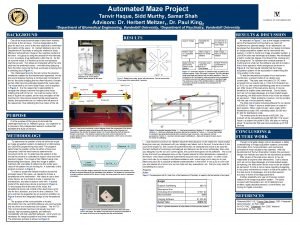Automated Maze Project 1 Department Tanvir Haque Sidd

- Slides: 1

Automated Maze Project 1 Department Tanvir Haque, Sidd Murthy, Samar Shah Advisors: Dr. Herbert Meltzer 1, Dr. Paul King 2 of Biomedical Engineering, Vanderbilt University, 2 Department of Psychiatry, Vanderbilt University BACKGROUND One of the most common tests of short term memory in animals is the rat maze. Food is designated as the prize for each run, and it is the rat’s objective to remember the location of the snack. Dr. Herbert Meltzer’s lab in the Department of Psychiatry is using the method to study effects of schizophrenic drugs on the cognitive centers of the brain. His group is using the process of microdialysis, in vivo, to analyze drug distribution within the rat. As the rat runs the maze, it is hooked up to the microdialysis machine as well. Two tubes are implanted within the rat’s skull into the prefrontal cortex – one delivering dialyzing fluid, the other removing the fluid, eventually emptying into a collecting duct (Figure 1). The challenges faced by the lab involve the physical limitations imposed by the experimental apparatus. As the two pound dialysis machine is continuously connected to the rat, the tubes bridging the two often become a burden, as they often become entangled against the maze walls. The maze itself is an 8 -arm radial maze, and is depicted in Figure 2. It is the researcher’s responsibility to navigate the dialysis machine throughout the maze, imitating the path of the rat. He must be careful not to lead or lag the rat’s speed, as the rat’s perception of the machine can have severe experimental repercussions. Ideally, the experiment can run without the influence of the researcher, thus reflecting the true nature of the rat. RESULTS & DISCUSSION RESULTS Acquire Image Calibrate the Image Convert the 32 bit image to an 8 bit image Pattern Match to a Specified Image Filter Image 2: Remove Small Objects Filter Image 1: Remove Border Objects Translate pixel value into physical coordinates Output Physical coordinates in array form Determine the pixel at the center of the pattern Figure 1: Microdialysis machine attached to rat. As the sketch shows, tubes connect at rat’s skull Figure 2: Radial 8 -arm maze, shown with dimensions. Rat can traverse the 51 inch span of the maze within 2 seconds. Figure 3: A schematic diagram of Lab. VIEW image acquisition and analysis program. Firstly, the image is acquired, it is then calibrated using focal length and camera lens curvature equations. Then it is converted to an 8 -bit image to make processing more manageable. It is filtered twice and then pattern matched to a specified image. The center pixel value of the identified pattern is identified and converted to physical coordinates to be outputted to the microcontroller. PURPOSE It is the purpose of this group to eliminate the challenges faced by Dr. Meltzer’s group. Our objective is to propose a fully independent research module that facilitates the study of memory. METHODOLOGY To determine the position of the rat within the maze an image acquisition system consisting of a USB camera and Lab. VIEW programming was used. The program determines the position of the rat within a frame and compares it with the next frame to determine the movement of the rat. To determine the position of the mouse the camera is calibrated to acquire clear and well resolved images. The image is then filtered using color thresholding techniques. Lastly the image is pattern matched with a template to determine the center pixel value of the pattern we are looking for. A schematic of the program is shown in Figure 3 In order to propel the dialysis machine across the enclosed area of the maze, we needed to choose a translational drive mechanism. We chose to use a lead screw device, as it is cheap to make, it requires low maintenance, and also is easy to work with. A scaled model of the lead screw device is pictured in Figure 4. To encompass the entire area of the maze, the translational device will consist of two lead screw arms, one for the x direction, and one for the y direction. The arms will then be supported by an aluminum scaffold, as Figure 5 shows the integrated design of the translational arm. The purpose of the microcontroller is to take information from the Lab. VIEW software and communicate it to the driver and mechanical arm system. The NI PCI 7342 microcontroller has four 8 -bit inputs, two 8 -bit outputs, high processing speeds, and software compatibility with the Lab. VIEW software. All of which are necessary for image acquisition and linear translation. The schematic process is shown as Figure 6. Figure 4: Lead screw mechanism in above diagram shows the components of the device. The motor’s rotational energy is transformed into linear energy via the threaded rod. Depending on the direction of angular rotation, the T-block along the shaft will traverse forward or backward. The distance traveled by the block will be monitored by the coupled optical encoder, which will count the rotational iterations, which can be converted to linear distance. Distance IN(Xn, Yn) Linear Translation OUT(Xn, Yn) Figure 6: This schematic diagram depicts the process sequence of the microcontroller. First an input is acquired followed by the calculation of the distance. This distance is converted into a current waveform and fed into the drivers. Finally, the driver powers the motor to represent a translation. Figure 5: Assembled Integrated Setup. 1 – Lead screw spanning x direction; 2 – Lead screw spanning y direction, 3 – Web cam monitoring rat position attached to underside of T-block; 4 – Crowned Rail system to counteract any generated torsional strain caused by linear movement – also balances moment generated by T-block; 5 – Aluminum bracket support scaffolding; 6 – Maze will be placed in open area in the center of scaffolding. I just received word from Dr. Meltzer about the final decision on the radial arm maze project. Everyone was very impressed with your designs and ideas, but in the end, it came down to the cost of the project vs. the number of experiments that we anticipate this maze to be used for. Current methods of combining microdialysis and behavior are far more rudimentary than what you designed, but for our own current goals, the current techniques will be sufficient. This is not to say that what you designed may not be of great interest to other laboratories, especially in the future, when these combined experiments become more common place. In other words, your work was by no means a worthless endeavor and I would urge you to hang on to your ideas and plans for a possible profitable implementation in the future. It was a joy to work with you and please let us know how we can help with any evaluations, etc. , that you may need for completing this course. Regards, Adam Figure 7: Correspondence with Dr. Adam Prus, of the Department of Psychiatry, in regards to the final decision of our project. Budget Support Scaffolding $99. 70 Mechanical Arm (Including driver electronics) Microcontroller $1527. 02 $895 Imaging Software Grand Total $1, 355. 00 $3876. 72 Table 1: A general breakdown of costs based on the four primary systems Figure 8: Screen shot of the Lab. VIEW software told to detect the black circle in the image. The tables to the left show the physical coordinates of the center of the circle to be outputted into the microcontroller. As depicted in Figure 7, due to the budget constraints set by the Department of Psychiatry we could not implement our planned design. As an alternative, we developed two theoretical models of our design principles: an Image acquisition system and a mechanical arm system. In order to model our image acquisition system, a Lab. VIEW code was developed and tested. We developed a test to model the degree of contrast of the marking and its background. To represent the contrast between a marking and a white rat, the software was told to locate a black circle against a white background as shown in Figure 8. Our test results indicate that the image acquisition system will be successful in determining the rat’s position in the maze. To test theoretical principles of our lead screw mechanism, a scaled model of our design was constructed. The parts used included a 3 V DC motor acquired from an erector set, a 1 foot 8 -32 threaded rod, an 8 -32 nut, and various scaffolding parts from an erector set. After review of the lead-screw device, it may be beneficial to explore other alternatives. Due to issues such as nut carriage stoppage, and load related speeddampening, the lead screw device may not be as reliable as perceived. These problems, however, can be avoided with the use of more powerful motors. The total cost of parts including software for our device is $3926. 42. Table 1 shows a break-down of costs for each system. Other costs include: Labor costs: $750, Maintenance costs: $45, marketing costs: $2, 000 and $1, 000 for distribution costs. The market price for the device is $50, 000. Our product will be competitively priced $45, 000. This would result in a bottom line profit of 20%. We plan on making about 10 devices the first year and eventually up to 500 devices. CONCLUSIONS & FUTURE WORK Though no tangible design will be developed, a better understanding of image acquisition systems, processed information from microcontrollers, and mechanical principles of linear actuators was obtained. With the development of the two theoretical models, the perceived design was realized and used for its educational purposes. After review of the lead-screw device, it may be reasonable to explore other alternatives. Due to issues such as nut carriage stoppage, and load related speeddampening, the lead screw device may not be as reliable as perceived. If price is not an issue regarding budgeting, it may prove worthwhile to invest in a belt drive system, as it is less prone to stoppages, and provides superior accuracy in terms of carriage placement. Another possibility is to use an IR sensor system instead of the image acquisition system. The parts involved with this system are: 40 IR detectors and emitters, eight piezostrip sensors, current filters, and Analog to Digital converters. REFERENCES "Motorola 68 HC 11 E. " Family Data Sheet. 2005. Freescale Semiconductor. 20 Feb. 2006 "NI PCI-7342. " Datasheet. Nov 2005. National Instruments. 20 Feb. 2006

